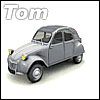West wrote:The caliper in the rear will create a lifting moment and in front, vice versa.
Actually, this is not posible. Anyway you put the caliper the reaction in the car is going to push the front axle downwards, except in reverse. But you get 4 or 5 inches of fictitious "extra-wheel-base". I'll guess this has repercusions in the entire attitude of the car.
It is like the CG: if you get down the COG, a naive person (like me for many years) would think it would improve ONLY the anti-roll tendency of the car, making more difficult to turn it over.
BUT lowering the COG, as you probably know, gives you better braking and acceleration... For example, an effect of SUV getting bigger and higher it is, not only to make them more prone to roll over: they brake and turn worse, because of this weight transfer effect. This is one of the first things you learn in your Basic Racing Course, so I suppose everybody understands me

.
If you do not understand me well, you can read
this 1.2 Mb five pages thing I wrote on the subject originally in spanish 
Instead of reading my text, you can also read the even longer explanation at
Brian Beckman's article that I ripped off (the conclusions about road design in my article is what is mine).
As Manchild says, shoot me, please (well, better shoot MC and then explain to me why)

Actually, if you do not get it, NOW I understand why nobody seems enthusiastic about any posts on car simulation wheel-by-wheel on real tracks at the tires forum. =;





